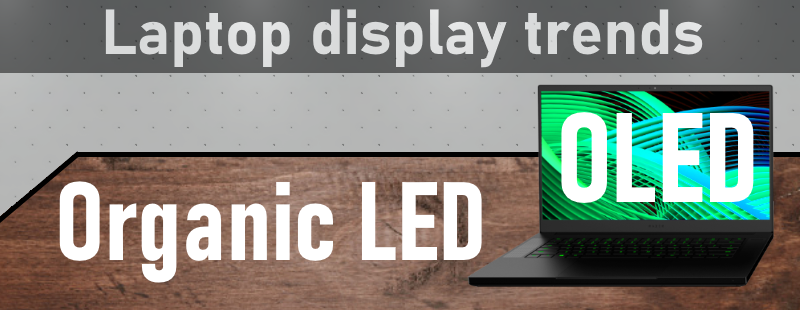
For those not accustomed to what LED and OLED mean, a little background information might be helpful.
LED stands for light-emitting diode. These are small solid-state devices that make light via the movement of electrons through a semiconductor. In practice, strips of tiny LEDs are placed at the bottom of the display, which emit light so that it spreads across the surface of the display. This light-generating method is called “backlight”. The backlight is necessary for displays because without it, the screen would look almost entirely black since the sub-pixels that give display’s colours do not emit any light themselves. Currently, almost all laptop and desktop displays on the market use LED technology.
OLED stands for “organic light-emitting diode”. In simple terms, OLEDs are made with organic compounds that light up when fed electricity. The main difference between them and the LEDs is their ability to generate light, eliminating the need for a backlight. That may not seem like a huge deal, but in practice, it opens the door for a much more extensive array of applications like extremely thin, flexible, and even rollable displays.
The first laptop with an OLED display was the Thinkpad X1 Yoga back in 2016. At the time technology was still in its infancy and unfortunately, the Yoga’s 14″ AMOLED display had plenty of issues, like burn-in, flickering or ghosting. Now in 2019, we can see a comeback of OLED screens and hopefully, the technology has matured enough that most issues are a thing of the past.
What makes OLED displays better than other standard backlit displays? OLEDs have superior sharpness and colour reproduction levels than anything else on the market. The main reason is that each pixel has an independent colour and light profile, and when it turns off, it is entirely off, meaning that the black levels of the display are practically perfect. In LED technology, when the pixel is off, the backlight still illuminates the pixel, giving it a slightly greyish tint.
In terms of reliability, there is no clear advantage of OLED over the LED, since both have their fair share of problems and can die pretty quickly under improper use.
For laptops, OLED technology is still in its infancy, and it will take at least one more year until we see mainstream features attached to it like G-Sync/FreeSync or faster response time and refresh rates with no downsides to them.
Here are laptops released in 2019 with OLED displays:
- Dell Precision 15 5540
- Dell XPS 15 7590
- HP Spectre x360 15t
- Clevo PB51
- Dell Alienware m15 R2
- Gigabyte Aero 15
- Dell Gaming G7 15 7590
- Asus ZenBook ProDuo
- Razer Blade 15
- Lenovo ThinkPad P53
Here you can find a search with all available OLED laptops.
Source: Digitaltrends



Leave a Reply